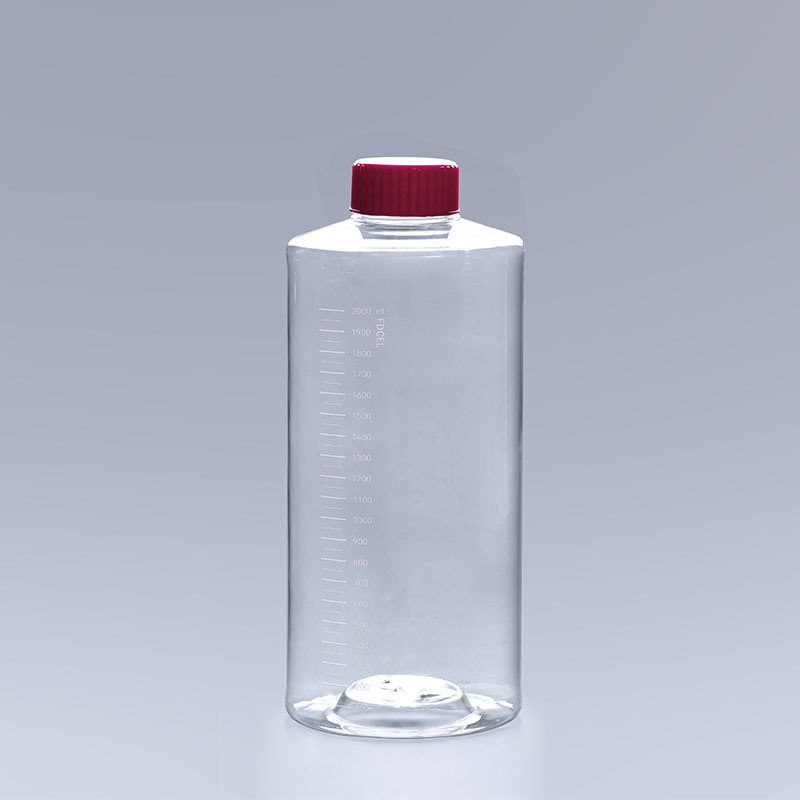Cell roller bottles are essential tools in modern life science research and the biopharmaceutical industry. Whether in laboratory cell studies or large-scale bioproduction, they play an indispensable role, facilitating progress from basic research to industrial production.
Design and Features of Cell Roller Bottles
Cell roller bottles are typically made of transparent plastic materials with excellent physicochemical properties, ensuring visibility of cell growth and smooth cultivation processes.
1.Capacity and Dimensions
Cell roller bottles usually range from 25 mL to 250 mL in volume, with the choice depending on experimental scale and cell culture requirements. For high-density cell cultures, larger bottles (e.g., 250 mL) are commonly used in large-scale bioproduction, such as virus or vaccine manufacturing.
2.Material and Design
Most cell roller bottles are made for single-use, eliminating contamination risks. The transparent bottle body allows easy monitoring of cell growth. The bottle base is typically flat or features a specially treated adhesion surface to support cell attachment and provide growth space.
3.Sterility
Sterility is a core feature of cell roller bottles. During production, they undergo rigorous sterilization and are packaged in a completely sealed manner to prevent contamination. This ensures a pure cell culture environment, minimizing contamination risks and guaranteeing reliable experimental results.

Applications of Cell Roller Bottles
Cell roller bottles are widely used in life sciences and biopharmaceuticals, covering multiple research and production fields.
1.Cell Biology Research
In cell biology research, cell roller bottles are extensively used for cell culture, differentiation, proliferation, and observation. Researchers cultivate various cell types to study fundamental biological processes such as growth, apoptosis, and stress responses. The bottles provide a stable environment, enabling well-controlled experimental conditions.
2.Virology and Microbiology Research
In virology and microbiology, cell roller bottles are key tools for culturing viruses and bacteria. For example, in vaccine production, specific cell types (e.g., Vero cells, HEK 293 cells) are cultured in roller bottles to amplify viruses. The bottles provide the necessary space and environment for viral replication, ensuring sufficient virus yield for vaccine development.
3.Biopharmaceuticals and Vaccine Production
Cell roller bottles are crucial in biopharmaceuticals and vaccine manufacturing. For instance, rabies vaccines often require virus propagation in Vero cells. Roller bottles offer a controlled and stable environment, ensuring optimal cell proliferation and efficient large-scale production with high quality.
Strategies to Prevent Cell Contamination
Cell contamination is one of the most common and challenging issues in cell culture, potentially caused by bacteria, fungi, mycoplasma, or viruses, which can severely impact experimental results or product quality. Key prevention strategies include:
1.Strict Aseptic Techniques
Aseptic operation is fundamental to preventing contamination. Personnel must follow strict protocols, including hand hygiene, workspace disinfection, and proper use of sterile tools. All equipment and reagents should be sterilized to avoid introducing contaminants.
2.High-Quality Cell Roller Bottles and Consumables
Using high-quality roller bottles with excellent sealing and contamination resistance is essential. Bottle caps should allow proper gas exchange while preventing microbial ingress.
3.Regular Monitoring and Testing
Routine checks of medium clarity, pH, and cell growth status help detect contamination early. Abnormalities should prompt immediate investigation. Techniques like PCR and microscopy can identify potential contaminants at an early stage.
Conclusion
Cell roller bottles are not only fundamental tools in cell biology and virology research but also vital in biopharmaceutical and vaccine production. By optimizing protocols, improving culture conditions, and using high-quality roller bottles, researchers and manufacturers can enhance experimental success rates and drive advancements in life sciences and biopharmaceutical industries.
The FAI climbed 5.9 percent year-on-year in the first 11 months of 2018, quickening from the 5.7-percent growth in Jan-Oct, the National Bureau of Statistics (NBS) said Friday in an online statement.
The key indicator of investment, dubbed a major growth driver, hit the bottom in August and has since started to rebound steadily.
In the face of emerging economic challenges home and abroad, China has stepped up efforts to stabilize investment, in particular rolling out measures to motivate private investors and channel funds into infrastructure.
Friday's data showed private investment, accounting for more than 60 percent of the total FAI, expanded by a brisk 8.7 percent.
NBS spokesperson Mao Shengyong said funds into weak economic links registered rapid increases as investment in environmental protection and agriculture jumped 42 percent and 12.5 percent respectively, much faster than the average.
In breakdown, investment in high-tech and equipment manufacturing remained vigorous with 16.1-percent and 11.6-percent increases respectively in the first 11 months. Infrastructure investment gained 3.7 percent, staying flat. Investment in property development rose 9.7 percent, also unchanged.
 English
English


















































